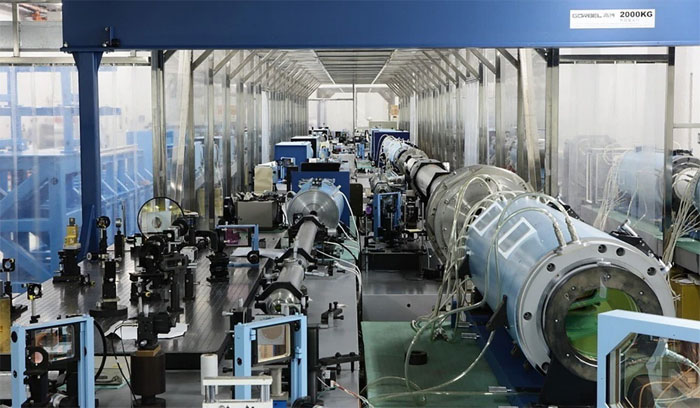Pouring 1 billion yuan, China 'fired a laser' at the fusion empire of nearly 50 billion dollars
China is showing great determination in the field of fusion energy.
At a facility in Shanghai the size of a football field, Chinese scientists are firing powerful laser beams at a pair of tiny gold cones in an attempt to replicate fusion. nucleus in the core of the Sun.
The cones, as small as a pencil tip, have narrow ends that point toward each other and emit hydrogen plasma. When two streams of hot gas collide at the right time and place, and in the right way, they trigger a fusion reaction - a process that can ultimately provide a sustainable and inexhaustible source of energy.
2026: China's fusion energy changes?
With government funding of up to 1 billion yuan (about 3,500 billion VND) over six years, Research Leader Zhang Zhe and colleagues from the Institute of Physics of the Chinese Academy of Sciences in Beijing began unprecedented experiments at the Shenguang II laser facility in Shanghai since summer 2020.
So far, the team has conducted three tests, with another scheduled for December 2021, and encountered some unexpected challenges. But initial results that show the theory works and part of the findings were published last week in the journal Acta Physica Sinica.
"Our goal is to achieve sustainable consolidation," Zhang said in a phone interview Thursday.

Shenguang II laser facility in Shanghai, where Chinese scientists are studying fusion energy. (Photo: Handout).
The race to fusion power heats up in August 2021, when researchers from the US National Ignition Facility (NIF) - at the Lawrence Livermore National Laboratory in Livermore, California - hit production. 8 times more energy than before.
The breakthrough has brought hope as well as added pressure to research groups in other countries, including China.
The NIF experiment aimed more than 100 powerful laser beams at a single target, using some of the largest laser generators on Earth, generating enough heat to distort mirrors but also reduce accuracy after multiple shots.
In China, researchers are looking for a cheaper, simpler way to achieve fusion with a less powerful laser. One result was a dual-cone ignition scheme developed in 1997 by Zhang Jie, a leading Chinese physicist and former dean of Shanghai Jiaotong University.
"We are making progress step by step. By 2026, a new generation of large-scale laser facilities will be completed in China. We will take this facility to a new level" - Team Leader Zhang Zhe speak.
A Beijing-based nuclear fusion scientist says the research budget in Shanghai is small compared to investments in other fusion projects. For example, the world's largest fusion research project, the International Thermal Experimental Reactor in the south of France (ITER), has an estimated cost of $45 to $65 billion.

The International Thermal Experimental Reactor in the south of France (ITER).
The idea of creating an artificial Sun to create a huge, inexhaustible and clean supply of energy dates back many decades, and scientists have come up with different sometimes competing approaches. competition for resources and attention.
ITER uses the biggest candidate for a laser approach (also known as inertial confinement fusion), Tokamak - a device that can generate and trap hot gas with an intense magnetic field to react. synthesis takes place internally.
"The double cone scheme is a great idea. Tokamak is generally thought to be more suitable for large-scale electricity generation, but some recent breakthroughs in experiments using lasers suggest this approach. could be a strong candidate , " the researcher requested anonymity because of professional secrecy.
"It's very difficult to predict which approach or which country will win the fusion energy race at this stage. There are so many uncertainties ahead. But in the end, different technologies, different countries may need to unite as one to bring unity from dream to life".
- China: Spending two billion yuan of bird flu
- Control laser fusion reaction
- China: spending 14.5 billion USD to clean Thai Ho
- China spent 277 billion USD to solve the problem of pollution
- The laser is capable of heating up to 15 million degrees Celsius
- China: Search market revenue reached nearly 200 million USD
- China spends 45 trillion dong on natural science
- What is fusion energy that Jeff Bezos invested millions of dollars in this technology?
- The US is about to test stealth laser weapons
- New Chinese laser guns can burn skin in 1 second at 800 meters
- Grid fusion synthesis power in 2050
- Russia built the world's most powerful laser super
 The US company is about to build a supersonic passenger plane of 6,000km / h
The US company is about to build a supersonic passenger plane of 6,000km / h Japan develops avatar robot as in fiction film
Japan develops avatar robot as in fiction film Australia tested the world's first mango picking robot
Australia tested the world's first mango picking robot America develops technology to separate water from animal waste
America develops technology to separate water from animal waste